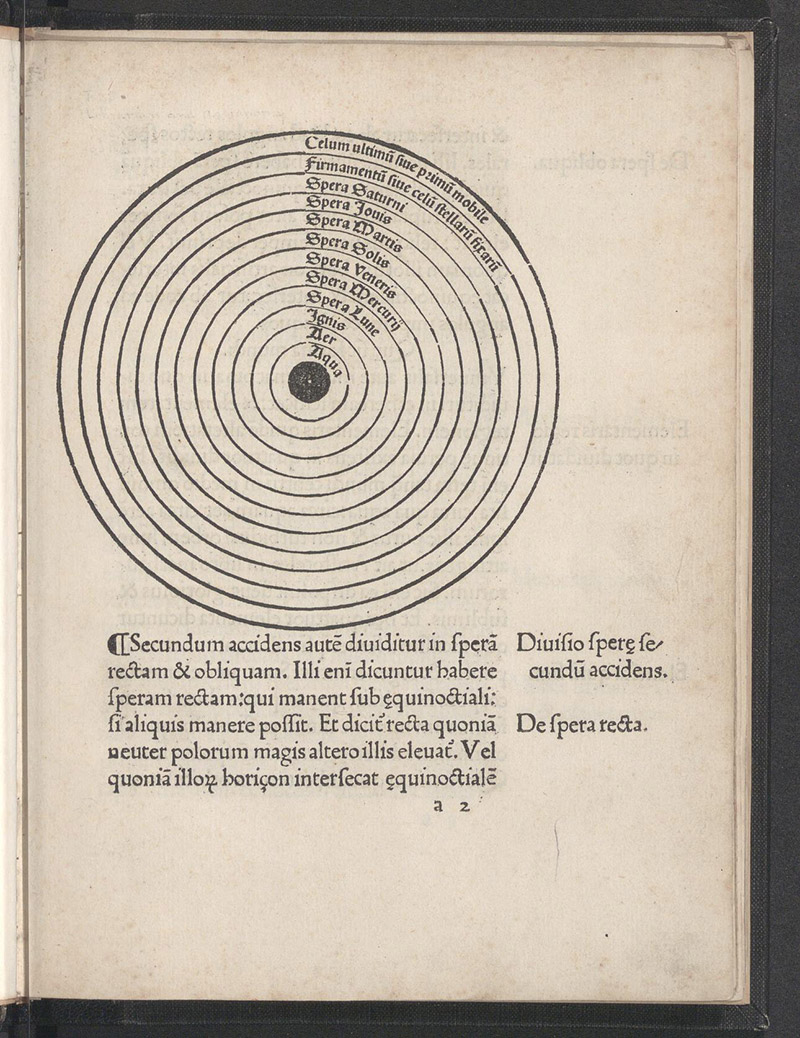Johannes de Sacrobosco

- Fol. a2r. Woodcut showing cross-section of the cosmos.
- Johannes de Sacrobosco (d. ca. 1244-1256). Sphaera mundi: Gerardus Cremonensis. Theorica planetarum.
- Venice: Franciscus Renner, de Heilbronn, 1478.
From the second half of the thirteenth century onward, Latin translations of Ptolemy’s Almagest were the main source for the study of theoretical astronomy in western Europe. However, this text was too complex to be used by students required to learn the basic knowledge of astronomy as part of the liberal arts curriculum at medieval universities. Thus, the Almagest was replaced by elementary manuals such as Johannes de Sacrobosco’s De sphaera mundi (On the Sphere of the World), also simply called Sphaera mundi, and the anonymous Theorica planetarum (The Theory of the Planets).
Ironically, little is known about the most popular writer of astronomy in the Middle Ages, Johannes de Sacrobosco, apart from a bit of information provided by the thirteenth-century astronomer Bartholomew of Parma in his commentary on the Sphaera mundi: Bartholomew merely says that Sacrobosco composed the Sphaera mundi during his stay at the university of Paris. Preserved in numerous manuscripts and early printed editions are the three extant treatises by Sacrobosco: De Algorismo is an introduction to the Hindu-Arabic numerals; De computo is a book on the computation of the Easter’s date, being also a critical examination of the Julian calendar; and De sphaera mundi is a textbook on astronomy that heavily borrows from Ptolemy’s Almagest, which had been translated into Latin in 1175 by Gerard of Cremona from an Arabic translation. As suggested in the title, Sacrobosco conceives the universe as a celestial sphere that embraces other smaller spheres, including the Earth, the Moon, and the five planets known at that time (Mercury, Venus, Mars, Jupiter, and Saturn). Aside from Ptolemy’s Almagest, other sources of the Sphaera mundi include the third-century BCE Greek mathematician, geographer, and astronomer, Erathostenes, and, particularly, the ninth-century Arabic astronomer, Al-Farghānī, who wrote a textbook on astronomy called Kitāb fī Jawāmiʿ ʿIlm al-Nujūm (Elements of Astronomy on the Celestial Motions). This work was first translated into Latin by John of Seville in 1335 and later by Gerard of Cremona around 1175, being still widely read throughout the fifteenth century.
Manuscripts and early printed books of the Sphaera included numerous illustrations in the form of diagrams, polyhedral shapes, cosmic sections, and models of orbs, all of which were designed to train students in creating three-dimensional mental images of the structures of the cosmos. For instance, the woodcut shown here represents a cross-section of the general structure of the cosmos according to the geocentric model. According to Sacrobosco, the sphere of the world is divided by substance into nine spheres. The Earth in the middle is surrounded by a succession of concentric orbs, in other words, spheric shells, beginning with three orbs representing the three elements (water, air, fire), followed by orbs containing the moon, the five planets, the fixed stars and, finally, ending with two other orbs: the firmament or heaven of the fixed stars and the so-called last heaven or “first moved”, which is the outermost sphere.
Select Bibliography
- Broecke, Steven Vanden. 2000. “The Use of Visual Media in Renaissance Cosmography: the Cosmography of Peter Apian.” Paedagogica Historica 36: 130-150.
- Daly, John F. 2008. “Sacrobosco, Johannes De (or John of Holywood).” In Complete Dictionary of Scientific Biography, Vol. 12 (digital edition). Detroit, MI: Charles Scribner’s Sons: 60-63.
- Grant, Edward. 1987. “Celestial Orbs in the Latin Middle Ages.” Isis 78 (2): 152-173.
- Kanas, Nick. 2005. “Volvelles! Early Paper Astronomical Computers.” Mercury 34 (2): 33-39.
- Lloyd, Steven A. 1989. “Lunar Volvelles and Moondials in Baroque Germany.” Journal for the History of Astronomy 20 (2): 121-127.
- Thorndike, Lynn. 1949. The Sphere of Sacrobosco and Its Commentators. Chicago: University of Chicago Press.
- Valleriani, Matteo, ed. 2020. De sphaera of Johannes de Sacrobosco in the Early Modern Period: The Authors of the Commentaries. Cham, Switzerland: Springer International Publishing.